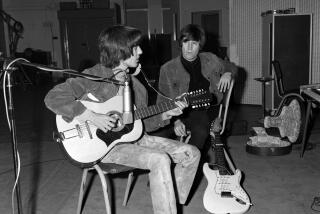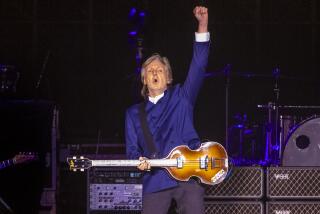Quest for the perfect guitar
It may not be an Arthurian tale of Sir Percival in pursuit of the Holy Grail, but Tony Baconâs âMillion Dollar Les Paulâ (Jawbone: 288 pp., $19.95 paper) is still about a romantic quest.
The object of his interest? The 1959 sunburst Les Paul electric guitar -- an instrument used by Jimmy Page, Eric Clapton, Michael Bloomfield, Billy Gibbons, Peter Green and many other knights of the rock round table.
Its craftsmanship, explains the author (whose other books include âThe Fender Electric Guitar Bookâ and âElectric Guitars: The Illustrated Encyclopediaâ), borders on the mythic: âInstruments built in that year are seen . . . as the peak of perfection. . . . Everything came together. . . . Ever since that time, guitarists, guitar makers, and guitar nuts have wondered how Gibson achieved such an extraordinary mix of mahogany, plastic, maple, rosewood, metal, and even, some say, magic.â
If youâre a weekend ax-meister, youâll understand what this magic refers to: The sound of a Les Paul knockoff pales next to the rich, meaty tones of the original. Thatâs one reason collectors pay huge sums.
Bacon surveys the history of the guitarâs creation, which dates to Paulâs experiments in the 1930s with solid-body, electric guitars with names like âthe log,â and then to Gibsonâs marketing of its first solid-body in 1952. Between 1958 and 1960, Bacon reports, Gibson produced 17,772 Les Pauls, with the sunburst design making up only about 8% -- quite low, quite rare, making its price-tag soar.
But seven figures? The author never finds one sold at this price, although he does come up with others selling for $200,000 and beyond -- in one 2007 sale, he reports, âa very flamey one-owner 1959 in excellent conditionâ went for $525,000.
âMillion Dollar Les Paulâ is more about the hunt -- which makes for an entertaining, fascinating glimpse into guitar culture, including talks with players such as Gibbons and the late Paul, as well as collectors such as Joe Ganzler, who authenticates original Bursts.
Often, the author turns philosophical, musing on why this particular guitar appeals to so many collectors. He finally realizes that itâs partly nostalgia -- because itâs âa reminder of their youthâ -- and this idea puts us back into the world of myth and all those quests for immortality.
âJust what is it about these guitars that makes them capable of reducing grown, hirsute men to jelly?â wonders Elliot Easton of the Cars. He gives up, conceding that the best explanation for âthe beauty and desirability of the late-50s sunburst Les Paul cannot be adequately expressed on paper.â
In this book, Bacon comes pretty close.
-- Nick Owchar
More to Read
Sign up for our Book Club newsletter
Get the latest news, events and more from the Los Angeles Times Book Club, and help us get L.A. reading and talking.
You may occasionally receive promotional content from the Los Angeles Times.






